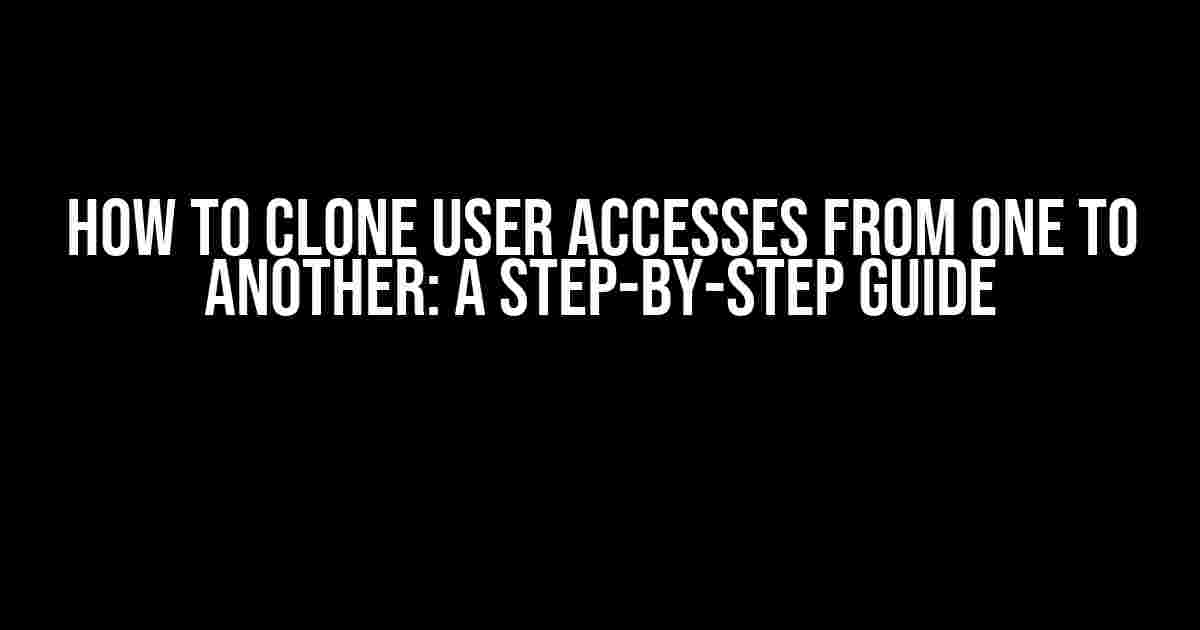Are you tired of manually setting up user accesses for new employees or contractors? Do you find yourself wasting precious time and effort recreating the same access levels for different users? Well, fear not! Cloning user accesses is a game-changer that can simplify your life and boost productivity. In this comprehensive guide, we’ll show you how to clone user accesses from one to another like a pro.
What is User Access Cloning?
User access cloning is the process of duplicating an existing user’s access levels and permissions to another user. This feature is often used in organizations to quickly set up new users with the same level of access as an existing user, saving time and reducing the risk of human error.
Why Clone User Accesses?
Cloning user accesses offers numerous benefits, including:
- Time-saving: Manually setting up user accesses can be a tedious and time-consuming task. Cloning eliminates the need for repetitive setup, saving you hours of work.
- Error reduction: Human error is a common occurrence when setting up user accesses. Cloning ensures that the same access levels and permissions are applied consistently, reducing the risk of errors.
- Consistency: Cloning ensures that all users with the same role or responsibilities have the same level of access, promoting consistency and fairness across the organization.
- Compliance: Cloning can help organizations comply with regulatory requirements by ensuring that user accesses are set up correctly and consistently.
Preparation is Key: Gathering Information and Requirements
Before you start cloning user accesses, it’s essential to gather the necessary information and requirements. Here’s what you need to do:
- Identify the source user: Determine the user whose accesses you want to clone. This user should have the correct access levels and permissions that you want to replicate.
- Determine the target user: Identify the new user who will receive the cloned accesses.
- Verify user roles and responsibilities: Ensure that the target user has the same role and responsibilities as the source user.
- Check for custom permissions: Verify if the source user has any custom permissions that need to be cloned.
- Confirm system compatibility: Ensure that the system or application you’re using supports user access cloning.
The Cloning Process: A Step-by-Step Guide
Now that you have gathered all the necessary information, it’s time to start the cloning process. Here’s a step-by-step guide to help you clone user accesses:
Step 1: Access the User Management System
Login to your user management system or the application where you want to clone the user accesses. This could be an HR system, an identity management platform, or a custom-built application.
Step 2: Navigate to the Source User’s Profile
Find the source user’s profile in the system and access their details.
Step 3: Identify the Access Levels and Permissions
Verify the source user’s access levels and permissions. Take note of the specific permissions, roles, and access groups they belong to.
Step 4: Clone the User Accesses
Use the system’s built-in cloning feature or a third-party tool to clone the source user’s accesses. This may involve clicking a “Clone” or “Duplicate” button, or using a command-line interface to execute a cloning script.
// Example of a cloning script using Python
import requests
# Set the source and target user IDs
source_user_id = 12345
target_user_id = 67890
# Clone the user accesses using the API
response = requests.post(
f"https://example.com/api/users/{target_user_id}/clone",
headers={"Authorization": "Bearer YOUR_API_KEY"},
json={"source_user_id": source_user_id}
)
if response.status_code == 200:
print("User accesses cloned successfully!")
else:
print("Error cloning user accesses:", response.text)
Step 5: Review and Verify the Cloned Accesses
After cloning the user accesses, review and verify that the target user has the correct permissions and access levels. Check for any errors or discrepancies.
Step 6: Test the Cloned Accesses
Test the cloned accesses to ensure that the target user can access the necessary resources and perform the required tasks.
Troubleshooting Common Issues
Cloning user accesses can sometimes result in errors or issues. Here are some common problems and their solutions:
| Error | Solution |
|---|---|
| Access levels not cloned correctly | Verify that the source user’s access levels are correct and try re-cloning the accesses. |
| Custom permissions not cloned | Check that the custom permissions are enabled for the target user and try re-cloning the accesses. |
| User roles not updated | Verify that the target user’s role is updated correctly and try re-cloning the accesses. |
Best Practices for Cloning User Accesses
To ensure successful user access cloning, follow these best practices:
- Test thoroughly: Test the cloned accesses to ensure that they work correctly and do not cause any issues.
- Document the process: Document the cloning process to ensure that it can be repeated and improved over time.
- Use automation: Use automation tools or scripts to streamline the cloning process and reduce the risk of human error.
- Limit access: Limit access to the cloning feature to authorized personnel to prevent unauthorized changes.
Conclusion
Cloning user accesses is a powerful feature that can save you time and reduce the risk of human error. By following the steps outlined in this guide, you can successfully clone user accesses and improve your organization’s overall efficiency. Remember to test thoroughly, document the process, and use automation to streamline the cloning process. With practice and patience, you’ll become a master of user access cloning!
Did you find this article helpful? Share your thoughts and experiences with user access cloning in the comments below!
Frequently Asked Question
Are you tired of recreating user accesses from scratch? Here are some frequently asked questions about cloning user accesses from one to another:
What is the fastest way to clone user accesses?
The fastest way to clone user accesses is by using the “Copy User” feature, which allows you to duplicate an existing user’s access and permissions with just a few clicks!
Do I need to reconfigure all the access settings when cloning a user?
No, you don’t need to reconfigure all the access settings. When you clone a user, the system will duplicate all the access settings, including roles, permissions, and group memberships, so you can save time and effort!
Can I customize the cloned user’s access settings?
Yes, you can customize the cloned user’s access settings as needed. You can add or remove roles, permissions, and group memberships to tailor the access to the new user’s specific needs!
Will cloning a user affect the original user’s access?
No, cloning a user will not affect the original user’s access. The cloned user will have a separate set of access settings that can be managed independently of the original user!
Can I clone multiple users at once?
Yes, depending on your system configuration, you may be able to clone multiple users at once using batch processing or import/export features. Check your system documentation for more information!


